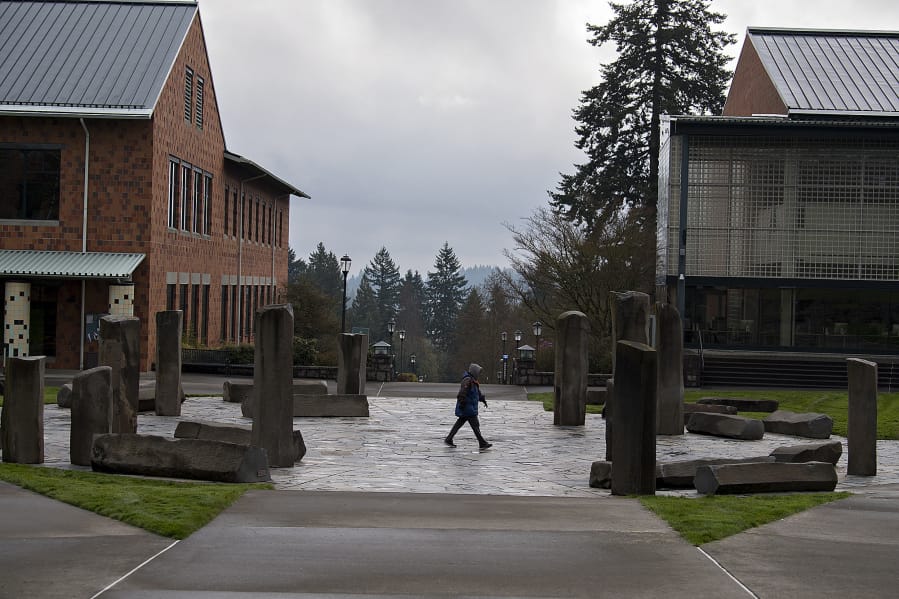With just a few months until high school graduation, advisers and career counselors are growing concerned about what lies ahead for the class of 2022.
“I feel like this year’s class is the one that was hit the hardest,” said Lorilee Huereña, a career guidance specialist at Hudson’s Bay High School in Vancouver.
Huereña works to identify post-graduation routes for graduating seniors, whether that is a two- or four-year university, an apprenticeship program, trade school, a gap year or a leap directly into the workforce.
A tumultuous three years of transitioning back and forth between remote and in-person education, along with the stress and fatigue of the pandemic, she said, has left many of her students exhausted and uninterested in filling out college applications and searching for financial aid options in comparison with preceding classes. Huereña has had to pivot to press students even harder to make them aware of their options.
“On college application day, schools come to visit, and a lot of students decide to apply on the spot — but we’ve just had so very few this year,” she said. “Students aren’t even finishing their applications. We’ve had to work so much harder to get the information out this year because of all the time lost.”
The Washington State Board of Community and Technical Colleges reported that nearly 50,000 fewer students were enrolled in Washington’s community and technical colleges in fall 2021 than in fall 2019 — a decrease of 23 percent.
Public four-year universities in Washington have witnessed a similar yet less-dramatic decline. In fall 2021, those schools enrolled 2,015 fewer first-year students than in fall 2019.
Additionally, the rate of enrollment decline was steeper between 2021 and 2020 than it was between 2020 and 2019 — an indication that, paired with the opinions of local career advisers, this year’s high school graduates may continue that downward trend.
Highlighting alternatives
Morgan Parker, Huereña’s colleague and a student pathways coordinator at Columbia River High School, has leaned into acknowledging and often encouraging other postsecondary options for her students. She stepped into the role in late 2019, meaning the bulk of her experience in advising has dealt with processing and predicting the impact of the pandemic.
“I’ve shifted my approach to senior entrance surveys,” Parker said. “I try to start students with two questions: What lifestyle do you want to live, and what problems do you want to solve?”
While daunting in their size and scope, Parker said the questions probe students to consider their intrinsic desires and interests, rather than imagine themselves within a specific pathway.
In neighboring Evergreen Public Schools, advisers start working with students as early as seventh grade with what are called “personal inventory assessments.”
Ryan Blodgett, a career counseling specialist at Union High School in Vancouver, outlines a holistic evaluation similar to the questions Parker referenced.
“We ask them to consider their skills, personality, preferred learning styles,” Blodgett said. “What makes them an individual, what things are important to them?”
According to Blodgett, who’s worked in career guidance at Evergreen and Educational Service District 112 for more than 20 years, he used to see 68-70 percent of students at Union pursuing postsecondary education in the fall following their graduation. In 2020, he said, that number dropped to 66 percent — and then dropped again to 63 percent in 2021.
Fatigue and burnout
Each of the advisers expressed sympathy for the class of 2022, who were just freshmen the last time they had a school year go fully uninterrupted by the pandemic. Now that students have returned to the building, they fear irreparable damage to academic morale and focus has already been done.
“It was really tough on a lot of students to be remote, but now that we’re returning to the nuances that make it feel like a normal high school, we’ve experienced everything on the spectrum,” Blodgett said. “A lot of students showing high anxiety levels who aren’t sure how to engage now that they’re back; it’s had some effect on our attendance, for sure.”
Parker suggested that a distaste for the classroom due to frustration from online learning has likely left some students with changed opinions about how they might fare in college.
“There has been a lot more interest in joining the workforce or asking about trades,” she said. “It may be a result of what’s going on in the world. Colleges also need to start thinking how they need to start making their pathway more attractive or personable.”
Laurel Rea, the vice chancellor for enrollment at Washington State University Vancouver, said she’s witnessed those issues with student motivation not only among current students, but among those who were accepted and never followed through.
“This is an anomalous period,” Rea said. “We haven’t seen large numbers of students going through a deferral process. Those numbers aren’t high, but what I think the number doesn’t capture are the students who just don’t show up. Some of them even attended orientation, but then they just don’t come. That data isn’t captured.”
In survey results from those students who didn’t enroll — a poll received all-time low response numbers — Rea said that a considerable number of students cited mental health and burnout among the reasons for not attending.
In response to data from the last two years, as well as the claims of advisers such as Parker, the Washington State University system extended its priority application deadline for first-time students from Jan. 31 to March 31. Scores on the ACT and SAT have also been permanently removed as application requirements, following a temporary lift of the requirement in April 2020.
“It’s something that’s long overdue,” Rea said. “We’re having conversations with them that it’s not all about their GPA, about the well-roundedness of their education. We’re really looking at the cultural wealth that each applicant brings.”
Despite the concerns, Rea said she anticipates that fall 2022 enrollment won’t continue to decline, but will match that of 2021. More than anything, she said, recruiters are telling her that it’s perhaps just a late application cycle as students express concerns about their grades and recover from waves of absences and class interruptions in January.
Nonetheless, career advisers in Southwest Washington hope they can lead students to what’s best for them and highlight often-overlooked opportunities for financial aid.
“There’s lots of people rallying around their students,” Huereña said. “We are not waiting around for things to do, let’s put it that way.”




